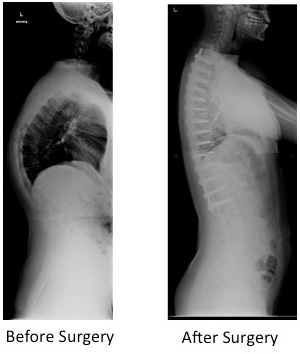Posterior Spinal Instrumented Fusion for Scheuermann’s Kyphosis is often recommended 1) to stop the kyphosis from getting worse, typically greater than 75 degrees, and 2) to correct the spinal deformity using modern surgical techniques and implants when non-surgical treatments do not relieve the pain or the kyphosis noticeably worsens.
Dr. Cho performs the surgery from the back of the spine (posterior approach) using appropriate implants (e.g., screws and rods) to straighten the curve and to immobilize the spinal segments as they heal and fuse together in a corrected position.
For the fusion part of the procedure, Dr. Cho uses patient’s own bone from the spine, along with bone from a bone bank (allograft). When the risk of bones not fusing together is high, Dr. Cho uses special biologic proteins to help the spine to heal better.
Another important goal of scoliosis surgery is to fuse the least number of spinal segments (vertebrae) to correct the deformity, which allows the patient to maintain as much motion in the spine as possible. Dr. Cho reviews multiple factors thoroughly, including patient’s age, clinical appearance as well as various x-rays, before deciding which levels to fuse. Dr. Cho is committed to providing the least invasive and risky procedure that will yield the best outcome for each patient.
Case Presentation
The patient is a 16-year-old young man who presented with progressive kyphosis. The patient had increasing back pain. He was also concerned about his worsening appearance.
Physical examination revealed a large hump. X-rays showed significant kyphosis in the thoracic spine. Surgery was offered to correct the deformity and fuse the spinal segments in a straighter position. The patient successfully underwent surgery to correct his kyphosis with excellent outcome.

